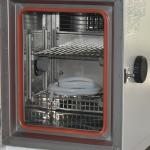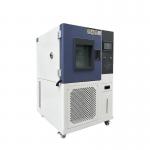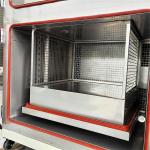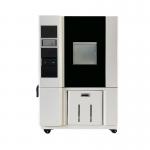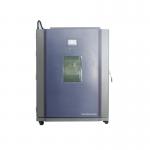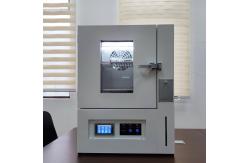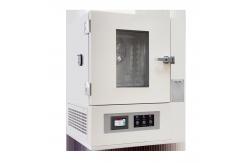In the fast-paced and highly competitive electronics industry, the
need for reliable and efficient testing equipment for electronic
parts is crucial. The Benchtop Small Climatic Temperature Humidity
Test Chamber emerges as a vital solution, specifically designed to
meet the unique requirements of testing electronic components. This benchtop test chamber is engineered to subject electronic
parts to controlled temperature and humidity conditions. It serves
as an essential tool for electronics manufacturers, research
institutions, and quality control laboratories. The primary purpose
is to evaluate the performance and durability of electronic
components, such as semiconductors, circuit boards, connectors, and
sensors, under various environmental stressors. By accurately
simulating real-world temperature and humidity scenarios, it helps
identify potential weaknesses, optimize product designs, and ensure
compliance with industry standards and regulations. - Compact and Space-Saving Design
- The chamber is constructed with a sturdy yet compact framework,
usually made of durable aluminum alloy or steel. Its benchtop size
makes it ideal for placement in limited laboratory or production
line spaces. The exterior is designed to be sleek and modern, with
a finish that is both resistant to scratches and easy to clean. The
interior is lined with a non-reactive and smooth surface, such as
stainless steel or a specialized anti-static coating, to prevent
any interaction between the chamber and the sensitive electronic
parts. The door is engineered for a tight seal, featuring a
reliable locking mechanism and a gasket that minimizes air leakage.
It also includes a clear viewing window, typically made of tempered
glass, allowing for easy visual inspection of the samples during
testing.
- Precision Temperature and Humidity Control Systems
- Temperature Control: The temperature control system is highly
accurate, capable of maintaining a wide temperature range,
typically from -20°C to +120°C, with an accuracy of ±0.3°C. It
utilizes advanced heating and refrigeration technologies, along
with a sophisticated feedback loop and multiple temperature
sensors. This ensures rapid and uniform temperature changes and
stability throughout the chamber. The control panel is
user-friendly and intuitive, allowing for easy programming and
adjustment of temperature settings, including the ability to create
complex temperature profiles with ramping and holding periods.
- Humidity Control: The humidity control system is equally precise,
capable of achieving humidity levels from 10% to 95% RH (Relative
Humidity), with an accuracy of ±3% RH. It employs a combination of
humidifiers and dehumidifiers, along with a well-designed air
circulation system. The chamber is equipped with humidity sensors
that continuously monitor the internal humidity, and the control
system adjusts the humidification or dehumidification processes
accordingly. This allows for the creation of stable and dynamic
humidity environments, mimicking real-world conditions.
- Temperature and Humidity Cycling: The chamber can perform precise
temperature and humidity cycling, enabling the simulation of rapid
changes in both parameters. For example, it can transition from a
low-temperature and low-humidity condition to a high-temperature
and high-humidity condition in a matter of minutes, depending on
the programmed profile. The control panel enables users to define
the rate of change, the duration of each stage, and the number of
cycles, providing a highly customizable testing environment.
- Advanced Instrumentation and Data Acquisition
- The chamber is outfitted with a comprehensive suite of sensors.
Temperature sensors are distributed throughout the chamber to
monitor the temperature at different locations, ensuring that the
samples experience the desired temperature conditions uniformly.
Humidity sensors are also strategically placed to accurately
measure the relative humidity. These sensors are connected to a
state-of-the-art data acquisition system that records and stores
all the temperature and humidity data. The data can be accessed and
analyzed in real-time or retrieved later for in-depth studies. The
data acquisition system is highly flexible and can be integrated
with electronics-specific software and databases, facilitating
seamless data transfer and analysis. It can also be configured to
send notifications and reports automatically, saving time and
effort for the users. Additionally, the control panel includes
built-in alarms and safety features that alert users in case of any
abnormal temperature, humidity, power failures, or equipment
malfunctions.
- Volume and Dimensions: With a small internal volume, usually ranging from 10 to 50
liters, it is optimized for testing individual electronic parts or
small batches. The external dimensions are designed to fit on a
standard laboratory bench, typically having a width of 30 to 60
centimeters, a depth of 30 to 50 centimeters, and a height of 50 to
80 centimeters. The interior dimensions are carefully engineered
for efficient air circulation and sample placement.
- Temperature Uniformity: The temperature uniformity within the chamber is maintained
within ±0.5°C during both high and low-temperature conditions. This
ensures that all parts of the electronic samples experience a
similar thermal environment, which is crucial for obtaining
accurate and reliable test results.
- Humidity Uniformity: The humidity uniformity is maintained within ±5% RH, guaranteeing
that the samples are exposed to consistent moisture levels
throughout the chamber.
- Temperature and Humidity Stability: Both the temperature and humidity systems offer excellent
stability, with minimal fluctuations over time. This allows for
consistent and repeatable testing, enabling electronics
manufacturers to compare results accurately and make informed
decisions about product improvements.
- Cycling Rates: The chamber can achieve rapid temperature cycling rates,
typically ranging from 5°C to 10°C per minute, and humidity cycling
rates of 5% to 10% RH per minute, depending on the specific
settings and the load within the chamber.
|
